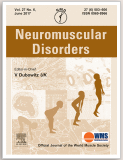 This study aimed to identify critical physiological outcome variables underlying reduced upper extremity task performance in Duchenne muscular dystrophy (DMD). These critical variables were used to propose an explanatory biophysical model of the upper extremity working mechanisms in DMD.
This study aimed to identify critical physiological outcome variables underlying reduced upper extremity task performance in Duchenne muscular dystrophy (DMD). These critical variables were used to propose an explanatory biophysical model of the upper extremity working mechanisms in DMD.
Twenty-three DMD patients (8-21 years) participated in this study. Correlations with Brooke scale and Performance of Upper Limb (PUL) score were very high for maximal active joint angle, high for maximal muscle torque and maximal surface electromyography amplitude, and moderate for mean echogenicity and maximal passive joint angle. Multivariable regression analysis showed that maximal active joint angle and maximal muscle torque were significantly associated with Brooke score (R2 = 0.91). Maximal active joint angle, maximal passive joint angle, and maximal muscle torque were significantly associated with PUL score (R2 = 0.94).
Based on the most critical physiological outcome variables, the authors constructed an exploratory biophysical model of the working mechanisms leading to limitations in upper extremity task performance. Better insights in these working mechanisms could support clinical management of upper extremity limitations and facilitate the development of interventions. In addition, the model could form the basis for new multi-layered outcome measures for clinical trials.
